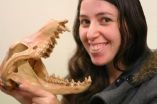(Press-News.org) University of British Columbia scientists may have uncovered a new explanation for how Alzheimer's disease destroys the brain – a profusion of blood vessels.
While the death of cells, whether they are in the walls of blood vessels or in brain tissue, has been a major focus of Alzheimer's disease research, a team led by Wilfred Jefferies, a professor in UBC's Michael Smith Laboratories, has shown that the neurodegenerative disease might in fact be caused by the propagation of cells in blood vessel walls.
Examining brain tissue from mouse models of Alzheimer's disease, Jefferies' team found nearly double the density of capillaries compared to normal mice. They also found a similarly higher density of capillaries in brain samples of people who had died of the disease, compared to samples from people who didn't have it.
Jefferies, in an article published online today by PLoS One, theorizes that the profusion of blood vessels is stimulated by amyloid beta, a protein fragment that has become a hallmark of Alzheimer's disease. The blood vessel growth, or "neo-angiogenesis," leads to a breakdown of the blood-brain barrier – the tightly interlocked network of cells that allows oxygen-carrying blood to reach brain tissue while blocking harmful substances, such as viruses.
"When the blood vessels grow, the cells of the vessel walls propagate by dividing," Jefferies says. "In the process of splitting into two new cells, they become temporarily rounded in shape, and that undermines the integrity of the blood-brain barrier, potentially allowing harmful elements from outside the brain to seep in."
The deterioration of the barrier might in turn allow the depositing of amyloid beta, which accumulates around neurons and eventually kills them.
Previous research had touched on the "leakiness" of the barrier, but it was assumed that it was caused by the death of blood vessels – not their growth.
Jefferies also sees an intriguing parallel with the "wet" form of age-related macular degeneration, in which blood vessels grow behind the retina and then leak blood and fluid, leading to hemorrhaging, swelling, and formation of scar tissue.
"Given the new link between both conditions, the next logical step in the treatment of Alzheimer's disease would be to look for treatments that specifically target blood vessel growth," says Jefferies, who holds appointments in the departments of microbiology and immunology, medical genetics and zoology, and is also a member of the Biomedical Research Centre and the Brain Research Centre.
###Jefferies collaborated with Dara Dickstein, a professor in the department of neuroscience at the Mount Sinai School of Medicine, New York. The team at UBC included graduate student Kaan Biron and technician Rayshad Gopaul.
The research was supported by grants from the Canadian Stroke Network and the Canadian Institutes of Health Research.
UBC researchers find a new culprit in Alzheimer’s disease: Too many blood vessels
Discovery could highlight a new avenue for drug development to combat neurodegenerative disorder
2011-09-01
ELSE PRESS RELEASES FROM THIS DATE:
EUR10, 000 Guaranteed on Golden Riviera's Latest Slots Tourney
2011-09-01
Golden Riviera Online Casino recently announced that they will be hosting a Guaranteed EUR10,000 Slots Tournament on the superb Video Slot, Hitman. Golden Rivera was the first in the industry to host a Slots Tournament of this kind and magnitude and to say that the previous EUR10K tourneys were an astounding success with its patrons would be an understatement.
Casino Manager, Emily Alessi, released this statement to the press: "The time has come again for our famous EUR10,000 Guaranteed FreeRoll Slots Tourney. Every one of our previous EUR10K tourneys has had such ...
Leicester scientists deploy space-age technologies at science-fiction style 'sick bay'
2011-09-01
A new hi-tech £1million-plus non-invasive disease detection facility, developed by the University of Leicester, has been unveiled today (Sept 1st 2011) for use in Leicester Royal Infirmary's A&E department.
It is designed to detect the "sight, smell and feel" of disease without the use of invasive probes, blood tests, or other time-consuming and uncomfortable procedures.
Scientists use three different types of cutting-edge technology in combination under a range of situations. All the methods are non-invasive, and could speed up diagnosis.
Scientists have surrounded ...
Robert Lauri: Discovery of Unreleased Timeless Musical Creations
2011-09-01
Robert Lauri reveals a new window of his musical creativity by now offering listeners some previously unreleased timeless melodies... all of them simply stunning.
The artist introduces us to some of the songs performed in English by Lorraine S'. All of his melodies and arrangements offer an opportunity for today's artists and performers.
For example, Robert Lauri first introduces us to the selections My Friend, Promised Land and Sunset. Wix widgets will be shared on Robert Lauri's social networking sites as well as on his music sites.
During his long musical ...
Tasmanian tiger's jaw was too small to attack sheep, study shows
2011-09-01
Australia's iconic thylacine, or Tasmanian tiger, was hunted to death in the early Twentieth century for allegedly killing sheep; however, a new study published in the Zoological Society of London's Journal of Zoology has found that the tiger had such weak jaws that its prey was probably no larger than a possum.
"Our research has shown that its rather feeble jaw restricted it to catching smaller, more agile prey," said lead author Marie Attard, of the University of New South Wales Computational Biomechanics Research Group. "That's an unusual trait for a large predator ...
Hubble movies provide unprecedented view of supersonic jets from young stars
2011-09-01
Stars aren't shy about sending out birth announcements. They fire off energetic jets of glowing gas travelling at supersonic speeds in opposite directions through space.
Although astronomers have looked at still pictures of stellar jets for decades, now they can watch movies, thanks to the NASA/ESA Hubble Space Telescope.
An international team of scientists led by astronomer Patrick Hartigan of Rice University in Houston, USA, has collected enough high-resolution Hubble images over a 14-year period to stitch together time-lapse movies of young jets ejected from three ...
Smoking after menopause may increase sex hormone levels
2011-09-01
A recent study accepted for publication in The Endocrine Society's Journal of Clinical Endocrinology & Metabolism (JCEM) found that postmenopausal women who smoke have higher androgen and estrogen levels than non-smoking women, with sex hormone levels being highest in heavy smokers.
Previous studies have shown that high levels of estrogens and androgens are potential risk factors for breast and endometrial cancer as well as type 2 diabetes. Cigarette smoking is a well established risk factor for chronic diseases such as cancer, cardiovascular disease and diabetes, but ...
Hot flashes may be fewer in older, heavier women
2011-09-01
A recent study accepted for publication in The Endocrine Society's Journal of Clinical Endocrinology & Metabolism (JCEM) found that among women aged 60 and above, heavier women have fewer hot flashes than their leaner counterparts. The inverse association between body size and hot flashes was observed only among the older women.
In the last decade, research on perimenopausal women has shown that heavier women tend to have more hot flashes. As a result of this research, clinicians began to observe obesity as a risk factor for hot flashes. However, according to this new ...
Podiatrist in Lancaster Enhances Practice Through Online Social Media Accounts
2011-09-01
Dr. Thomas Neuman, podiatrist in Lancaster and Northridge, has recently launched the practice's social media websites - Facebook and Twitter. These social media channels were set up to maintain a superior level of communication and interaction with patients at any point during the day. Patients can now access more personalized information, as well as learn more about other patients' experiences with Dr. Neuman.
"My patients use the Internet more and more these days, including sharing information and interacting with other patients on popular social media websites. ...
Not all care homes are bad, argues expert
2011-09-01
Many care homes provide first rate care, despite relentless negative media coverage, argues an expert on bmj.com today.
Graham Mulley, Emeritus Professor of Elderly Care at the University of Leeds, calls on the media and high profile individuals to "balance the prevailing nihilism" and celebrate all the excellent work that is taking place in many care homes.
His views come after he was asked to be a consultant adviser for an undercover television exposé of nursing homes.
Media reporting of care homes is rarely positive, he writes, yet the latest report from the Care ...
Cosmetic Dentist in West Orange Offers Advanced Dental Treatment with Laser Dentistry
2011-09-01
New Jersey top dentist, Dr. Ivan Stein of Northfield Dental Group, is treating patients with more precision and efficiency with recent advancements in dental technology. New laser devices enable Dr. Stein to provide the best possible care in his Livingston office.
Laser dentistry is a form of dentistry that allows for the treatment of highly specific areas by laser without damaging the surrounding tissues. For years lasers have been used in dentistry to treat a number of dental problems and they continue to improve and grow in popularity.
"The use of lasers ...
LAST 30 PRESS RELEASES:
Making lighter work of calculating fluid and heat flow
Normalizing blood sugar can halve heart attack risk
Lowering blood sugar cuts heart attack risk in people with prediabetes
Study links genetic variants to risk of blinding eye disease in premature infants
Non-opioid ‘pain sponge’ therapy halts cartilage degeneration and relieves chronic pain
AI can pick up cultural values by mimicking how kids learn
China’s ecological redlines offer fast track to 30 x 30 global conservation goal
Invisible indoor threats: emerging household contaminants and their growing risks to human health
Adding antibody treatment to chemo boosts outcomes for children with rare cancer
Germline pathogenic variants among women without a history of breast cancer
Tanning beds triple melanoma risk, potentially causing broad DNA damage
Unique bond identified as key to viral infection speed
Indoor tanning makes youthful skin much older on a genetic level
Mouse model sheds new light on the causes and potential solutions to human GI problems linked to muscular dystrophy
The Journal of Nuclear Medicine ahead-of-print tip sheet: December 12, 2025
Smarter tools for peering into the microscopic world
Applications open for funding to conduct research in the Kinsey Institute archives
Global measure underestimates the severity of food insecurity
Child survivors of critical illness are missing out on timely follow up care
Risk-based vs annual breast cancer screening / the WISDOM randomized clinical trial
University of Toronto launches Electric Vehicle Innovation Ontario to accelerate advanced EV technologies and build Canada’s innovation advantage
Early relapse predicts poor outcomes in aggressive blood cancer
American College of Lifestyle Medicine applauds two CMS models aligned with lifestyle medicine practice and reimbursement
Clinical trial finds cannabis use not a barrier to quitting nicotine vaping
Supplemental nutrition assistance program policies and food insecurity
Switching immune cells to “night mode” could limit damage after a heart attack, study suggests
URI-based Global RIghts Project report spotlights continued troubling trends in worldwide inhumane treatment
Neutrophils are less aggressive at night, explaining why nighttime heart attacks cause less damage than daytime events
Menopausal hormone therapy may not pose breast cancer risk for women with BRCA mutations
Mobile health tool may improve quality of life for adolescent and young adult breast cancer survivors
[Press-News.org] UBC researchers find a new culprit in Alzheimer’s disease: Too many blood vesselsDiscovery could highlight a new avenue for drug development to combat neurodegenerative disorder


